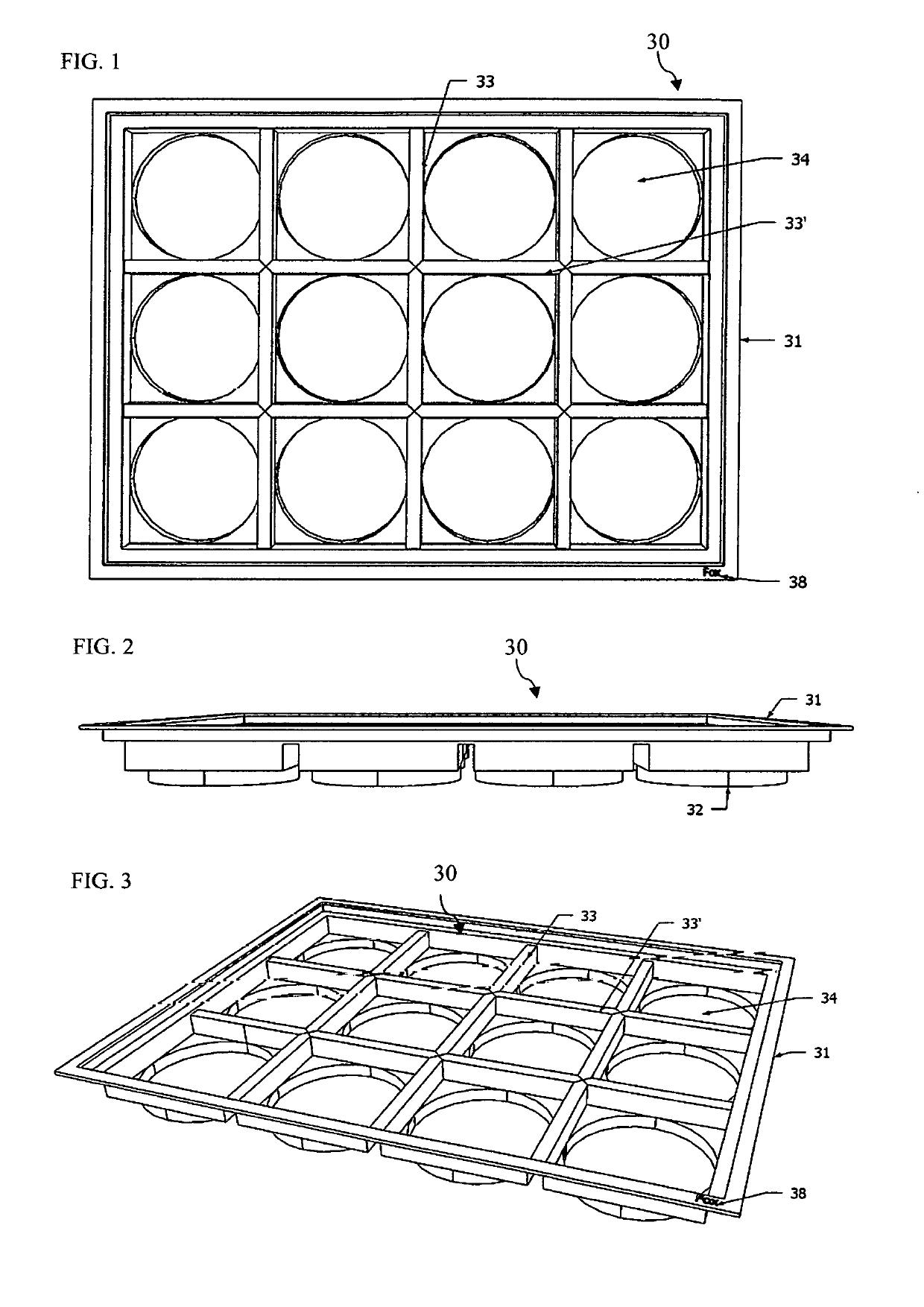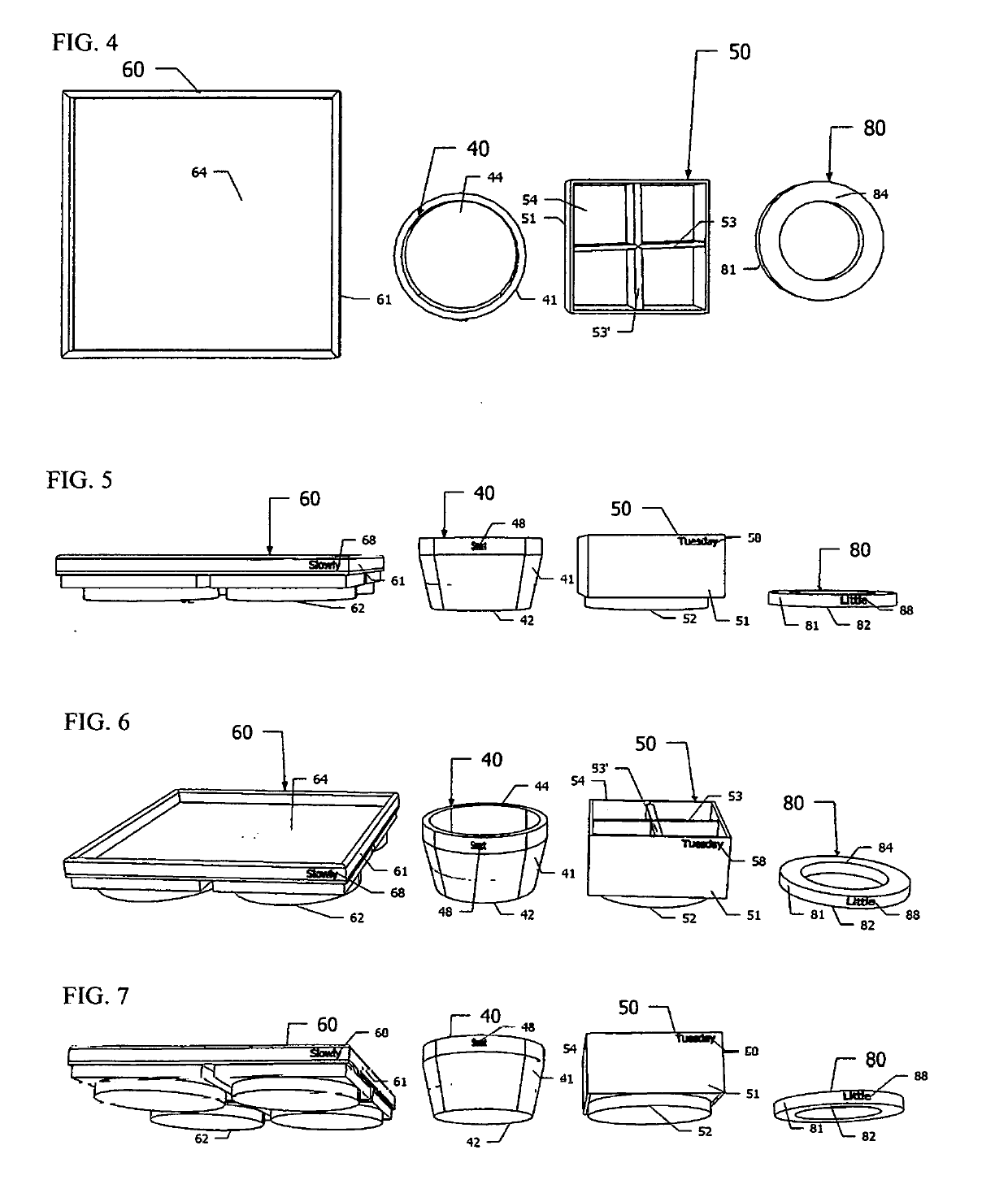The related art does not solve the problem of letting hosts or users of the disposable or reusable tray or plate adapt the food tray or plate to their different needs and preferences.
Therefore the related art does not solve the need of users to hold a greater variety of foods while keeping the foods separate; nor does it allow users to hold larger quantities of non-
solid foods such as soups or a plurality of larger quantities of non-
solid foods; nor does it allow users to adapt the configuration of the containers to their individual preferences.
The related art also does not provide an easy way for users to reconfigure a disposable or reusable tray to allow the user to securely carry various quantities of non-solid foods and beverages together with other foods and / or sauces, while keeping each item separate, yet facilitating portability by keeping all items secure on a single, easy-to-carry disposable or reusable tray.
Because the related art does not solve the need of users to securely carry all of their food and beverage items on a single tray the related art leaves users with either making multiple trips to carry more plates, bowls and cups than they can carry with two hands; having to use a tray if one is available which in many situations a tray is not provided; or attempt to carry multiple dishes, bowls and cups and incur a higher potential for accidental spills causing potential embarrassment; injury to themselves and others from being burned by hot food or beverage items or slipping on the spilled food or beverage; damage to clothes, personal items, carpeting, upholstery, and other property; and potentially expensive legal claims against a host of an event or owner of a facility.
The related art does not provide a way for users to safely carry a larger number and variety of food and beverage compartments safely and securely to reduce risks of
spillage and potential injury from
hot liquids that are spilled.
The related art does not hold a significant variety of different types of containers in a secure way that would
resist spilling if the user tilts the tray excessively or is bumped by another person.
The related art also does not provide a way to hold as wide a variety of standard size cups securely in combination with holding food containers.
Users who need to also get food for other people, such as parents getting food for
small children or caretakers getting food for elderly or
disabled people in their care, experience even greater difficulty in getting the food and beverages for each person without having to make multiple trips which would interrupt their supervision of, and their
visual attention to, such people.
The prior art does not provide an easy way for these users to carry multiple beverages and food items for more than one person securely in a single trip or to easily stack trays and food containers to carry enough food for multiple people in an organized, secure way.
The prior art does not provide a way for users to keep a wide variety of foods separated in a compact personal space on a table.
Instead users may get multiple full sized plates with fixed dividers providing only a few compartments, bowls and / or cups to keep food separate, which then take up an larger amount of table space than is optimal potentially causing insufficient table space for all users sitting together, food to be more difficult to access, discomfort for users trying to access all of the food, more spills and accidents accessing the food, and potential embarrassment if one person's food causes another person to have difficulty finding a space to put all of his or her food on the table.
The related art also does not provide a way for a host to easily encourage consumers to take smaller portions of non-solid foods so that such foods are not wasted, or so that foods that are more expensive, more desirable, or in limited quantity are not consumed too quickly by those who are in the front of the line, as might occur when typically sized bowls are provided for such foods.
The related art also does not provide an easy way for users to select a wider variety of smaller portions since typical disposable bowls—such as common ten ounce, twelve ounce, or twenty ounce sizes—are designed to accommodate a sizeable portion.
Users of typical bowls would have difficulty carrying multiple bowls for each non-
solid food such as soups, and might feel embarrassed by only putting a small portion in each large bowl since it could feel wasteful of a disposable bowl for such a small portion.
In some cultures, guests that only add a small portion to a typically-sized bowl could appear to dislike the food which could be considered insulting to the host or to the person who made the food.
Persons with
dietary restrictions and limitations could feel especially uncomfortable in such a setting and potentially feel social pressure to consume an amount of food that for them would be unhealthy.
The related art also fails to minimize the impacts of disposable items on the environment and the economic cost of the disposable items to hosts.
Typical bowl sizes might require a user to use many bowls in order to sample multiple items in a single trip or to use more bowls to avoid residual flavors from a prior use, which then leads to the greater waste of those larger bowls.
The excess material used increases economic costs for hosts and increases harmful impacts on the environment when the materials are disposed of in a landfill or incinerator, or require more energy in a recycling process.
The related art also does not provide an immediate way for users to determine if a disposable or reusable tray, plate, cup, bowl or other utensil is one that he or she selected for personal use or if the item was selected and potentially used by another person, thereby risking embarrassment, potential
exposure to another person's germs and consequently potential adverse health impacts.
Often, if a user is unsure whether a disposable item is the one that he or she is using, the item and food contained in the item will be thrown away and the participant may get another disposable item and more food causing
food waste, higher materials costs for the host, and increased adverse environmental
impact.
 Login to View More
Login to View More  Login to View More
Login to View More 


